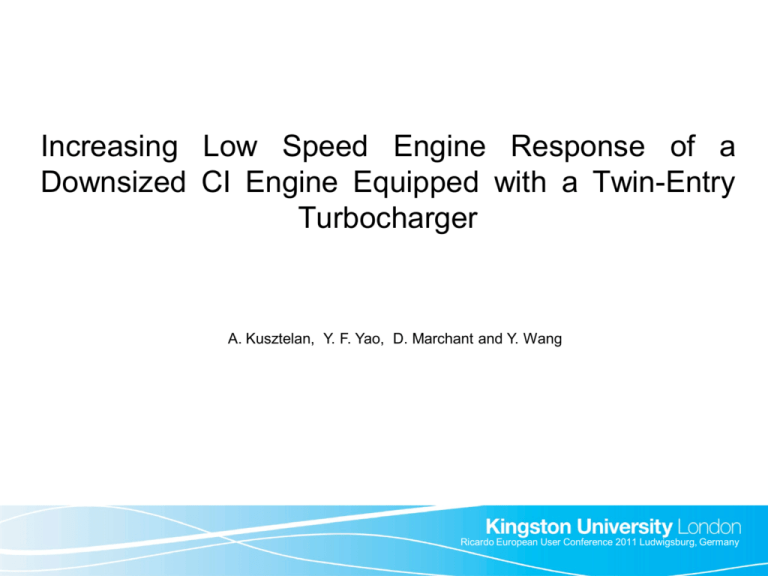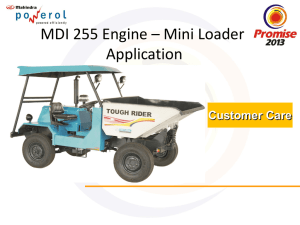Increasing Low Speed Engine Response of a Downsized
advertisement

Increasing Low Speed Engine Response of a
Downsized CI Engine Equipped with a Twin-Entry
Turbocharger
A. Kusztelan, Y. F. Yao, D. Marchant and Y. Wang
Ricardo European User Conference 2011 Ludwigsburg, Germany
Benefits of a Turbocharger
Increases the volumetric efficiency of the engines combustion chamber
Creates a higher mass flow rate enhancing the brake mean effective pressure acting
upon the piston crown
www.engineerography.com
Ricardo European User Conference 2011 Ludwigsburg, Germany
Research Objective
• The emphasis today is to provide feasible engineering solutions to create more
economical engines whilst still maintaining a high specific power output
• One solution is pressure boosting, allowing automotive manufacturers to
adopt smaller displacement engines, commonly known as “engine downsizing”
• A common problem that occurs when turbocharging downsized diesel engines is the
response of the turbine at low engine speeds
The application of a twin-entry turbocharger
suggests that the pulsating energy of the
exhaust gas is better utilized providing an
increased turbine response at lower RPM
ranges.
www.borgwarner.com/turbodriven
Ricardo European User Conference 2011 Ludwigsburg, Germany
Twin-Entry Turbocharger Configuration
In contrast to a single-entry turbochargers, a twin-entry turbine housing will better utilize the
pulsating energy of the exhaust gas [1]
Potential benefits for “downsizing” applications:
•
Increased turbocharger response at low engine speeds
•
Reduced turbocharger delay time i.e. lag providing improved
vehicle “drivability”
Disadvantage:
•
Cost of castings for complex twin-entry geometry
www.modified.com
[1] Aghaali H. and Hajilouy-Benisi A. (2008). Experimental modelling of twin-entry radial turbine. Iranian Journal of Science & Technology, Transaction B, Engineering, Vol. 32, No. B6, pp 571-584
Ricardo European User Conference 2011 Ludwigsburg, Germany
Ricardo Wave 1D Simulation
1D simulation software accurately replicates an engine using different configurations
and operating conditions
Quickly and precisely change variables
Time saving
Initial engine cell testing procedures performed using software
Cost saving
Identify any initial problems early in the design and testing stages
Development Tool
Viable validation source
Research Tool
Our research based on a “Down sized” Renault 1.5 DCi Engine
Ricardo European User Conference 2011 Ludwigsburg, Germany
1.5 DCi K9K Engine
1.5 DCi frequently cited as a bases for “ down sized”
CI engine development – “Engine Technology
International [2]”
Fitted as standard with a BorgWarner single-entry
Turbocharger
www.renault.com
[2] Weissbaeck M. (2011). “Diesel Downsizing”, Engine Technology International, January, p. 26
Ricardo European User Conference 2011 Ludwigsburg, Germany
1D Simulation Model
Simulation based on the Wiebe combustion model [3] and a series of user
defined parameters taken from the original engine.
Bore
76 mm
Stroke
80.5 mm
Exhaust Valve Lift
8.6 mm
Inlet Valve Lift
8.0 mm
Compression Ratio
17.9 : 1
Firing Order
1-3-4-2
No. Of Cylinders
4
No. Valves Per Cylinder
2
Inlet Manifold Temp
~ 120 °C
Exhaust Manifold Temp
~ 800 °C
[3] Ricardo Wave 8.3 User Manual
Ricardo European User Conference 2011 Ludwigsburg, Germany
Compressor: BorgWarner KP 35
A suitable flow map [4] for the compressor needs to imported within
the software to create the correct turbocharger operating conditions :
Volumetric Flow Rate m3/s
Default Ricardo extrapolation methods are used to create operating conditions
not originally presented (or available) from manufacturer flow maps.
[4] BorgWarner compressor flow map (http://corsaclub.forumcommunity.net/?t=32167079 (2010). (Accessed: December 2010)
Ricardo European User Conference 2011 Ludwigsburg, Germany
Engine Boundary Conditions
• For the purpose of this research the model is based on a steady
state simulation cycle (1000 – 5000 RPM)
• Transient simulation models based on the current Euro Drive Cycle
are planned
• Identical compressor geometry was used for both the single
and twin-entry models
Variables defined using {x} then
set within the constant table at
each RPM stage
Further typical parameters include:
• Fuel/Air ratio {FA}
• Turbocharger shaft speed {CRPM}
Ricardo European User Conference 2011 Ludwigsburg, Germany
Single-Entry Configuration Model:
4 into 1 manifold geometry: Strong flow interactions and turbulent mixing of the
pulsating exhaust gases within manifold
Energy transfer from exhaust gas to
turbine impeller are therefore not optimised
Ricardo European User Conference 2011 Ludwigsburg, Germany
Twin-Entry Configuration Model:
Using the standard firing order of 1-3-4-2 the manifold can be tailored to keep
the varying exhaust gas pulses separate [5]
Both models were run using the same boundary
conditions for 100 simulation cycles
[5] Hiereth, H. and Prenninger, P. (2003) Charging the internal combustion engine. Springer: New York
Ricardo European User Conference 2011 Ludwigsburg, Germany
Simulation Model Validation
Data provided by Renault:
• Peak engine power 45 Kw @ 4000 RPM
• Fuel consumption (26.7 mpg)
• Turbocharger type (BorgWarner KP 35)
• Bore and stroke dimensions
Calculated parameters:
• Adiabatic combustion temperature (2440 ˚C)
• Torque @ 4000 RPM (107.98 Nm)
• BMEP @ 4000 RPM (9.046 Bar)
• Volumetric efficiency @ 4000 RPM (1.2)
Ensure engine model is creating the correct power and torque
output using pre defined parameters and BorgWarner
compressor flow map at 4000 RPM
Accurate correlation between known and calculated data
Ricardo European User Conference 2011 Ludwigsburg, Germany
Validation Results
• Power as indicated from Renault is 45 Kw @ 4000 RPM
• Results show good correlation between given and simulated power output
50.00
45.00
Renault Indicated Power Value (45Kw)
40.00
Power (Kw)
35.00
30.00
25.00
20.00
15.00
10.00
5.00
1000
1500
2000
2500
3000
3500
4000
4500
Engine RPM
Ricardo European User Conference 2011 Ludwigsburg, Germany
Calculated Results Validation
• Torque was calculated using engine speed specified at maximum power (108 Nm)
• The calculated value was then compared to the simulated results (108.06 Nm)
120.00
110.00
Torque (Nm)
100.00
90.00
80.00
70.00
60.00
50.00
40.00
1000
1500
2000
2500
3000
3500
4000
4500
Engine RPM
Ricardo European User Conference 2011 Ludwigsburg, Germany
Calculated Brake Mean Effective Pressure (BMEP)
• Calculated BMEP @ 4000 RPM is 9.046 Bar
• Simulated recorded value @ 4000 RPM (9.30 Bar)
2.7 %
Improvement
10.00
9.00
BMEP (Bar)
8.00
7.00
6.00
5.00
4.00
1000
1500
2000
2500
3000
3500
4000
4500
Engine RPM
Ricardo European User Conference 2011 Ludwigsburg, Germany
Simulation Results
A series of comparison plots were created using the simulation results to
indicate a potential change in engine performance when using the twin-entry
geometry turbocharger:
• Turbocharger shaft speed - indication as to whether impeller spool increases at low engine
speeds (1000-3000 RPM)
• Power and torque variations - through improved turbocharger performance
• BMEP and volumetric efficiency - through improvements in compressor pressure ratio
Correlation between turbine and compressor performance using
plotted engine drive lines
Ricardo European User Conference 2011 Ludwigsburg, Germany
Twin and Single–entry Comparison Results
Due to a potential improvement in energy transfer caused by the twin-entry turbine housing
and subsequent manifold design the shaft speed is increased.
Clear increase across the engine speed range of 1000-3500 RPM, but greatest
percentage improvement of 31.7% visible at 2500 RPM
240000
220000
Shaft Speed (RPM)
200000
180000
160000
140000
Twin-Entry
120000
Single-Entry
100000
80000
60000
40000
1000
1500
2000
2500
3000
3500
4000
4500
Engine RPM
Ricardo European User Conference 2011 Ludwigsburg, Germany
Power and Torque Improvements
An increase in power and torque is also clearly visible within the speed range of 1000-3500 RPM
indicating improved engine speed performance due to the adoption of twin-entry turbocharger
Twin-Entry
50.00
Single-Entry
120.00
45.00
110.00
40.00
100.00
Torque (Nm)
Power (Kw)
35.00
30.00
25.00
20.00
90.00
80.00
70.00
15.00
60.00
10.00
50.00
5.00
1000
1500
2000
2500
3000
Engine RPM
3500
4000
4500
40.00
1000
1500
2000
2500
3000
3500
4000
4500
Engine RPM
Greatest increase of 28.1% at 2500 RPM for both the power and torque results
Ricardo European User Conference 2011 Ludwigsburg, Germany
Volumetric Efficiency Improvement
1.50
350
1.40
300
1.30
Air Flow (Kg/Hour)
Volumetric Efficiency
• An increase in the compressor speed would normally result in an improved air flow
rate into the engine
• This in-turn will theoretically create a higher volumetric efficiency as verified by the
simulation results
1.20
1.10
1.00
0.90
200
150
Twin-Entry
100
Single-Entry
50
0.80
0.70
1000
250
1500
2000
2500
3000
Engine RPM
3500
4000
4500
0
1000
1500
2000
2500
3000
3500
4000
4500
Engine RPM
Both VE and Air flow indicate an increase of 23.1% at 2500 RPM
showing a clear improvement during low engine speed conditions
Ricardo European User Conference 2011 Ludwigsburg, Germany
Brake Mean Effective Pressure (BMEP)
• A similar trend is illustrated by the increase in BMEP and compressor
discharge pressure due to the increased air mass flow rate
2.20
9.00
2.00
Compressor discharge pressure (Bar)
10.00
BMEP (Bar)
8.00
7.00
6.00
1.80
1.60
1.40
5.00
1.20
4.00
1000
1.00
1000
1500
2000
2500
3000
Engine RPM
3500
4000
4500
1500
2000
2500
3000
3500
4000
4500
Engine RPM
Ricardo European User Conference 2011 Ludwigsburg, Germany
Effect of increased engine performance on turbocharger
Using simulated PR and M two drive lines are plotted representing both the single/twin entry geometry
This clearly indicates what effect the changed turbine geometry has on the compressor performance
Twin-Entry
Single-Entry
Volumetric Flow
Rate m3/s
• The increased flow rate produced by the compressor due to the twin-entry turbine geometry is clearly visible.
• Drive line (twin-entry) shifted into higher efficiency areas indicating increased compressor performance
Ricardo European User Conference 2011 Ludwigsburg, Germany
Simulation Outcomes and Observations
• Application of a twin-entry volute design clearly effects engine performance during
low RPM conditions
• Twin-entry geometry indicates a greater energy transfer to the turbine impeller from
the split pulse exhaust gases
• Improved compressor performance providing better torque and power
characteristics during low engine speed conditions
• The drive line locations on the compressor map moved to higher efficiency zones
due to the increase in air flow rate
• Reducing turbocharger delay time due to faster impeller spooling time
• Increasing engine response during 1000-3000 RPM engine speed conditions
• Potential cost reductions over currently available designs e.g. turbo-compounding and
2-stage turbocharging
Ricardo European User Conference 2011 Ludwigsburg, Germany
Improvement Percentage within the 1000-3500 RPM Range
Power
15.1 %
Torque
15.1 %
BMEP
15.1 %
Volumetric Efficiency
13.1 %
Mass Air Flow
13.0 %
Shaft Speed
16.2 %
Comp. Discharge Pressure
7.25 %
Clear improvement in engine and turbocharger performance
due to the use of a twin-entry turbocharger
Ricardo European User Conference 2011 Ludwigsburg, Germany
Future Simulation Validation
• The dynamometer facilities at Kingston University London are capable of performing
transient drive cycle tests using the 1.5 DCi Renault engine
• Using recorded test cell data to validate the 1D simulation results
• Apply recorded data taken from dyno test to create more accurate boundary conditions
for the simulation model
Application of 3D CFD
Use CFD resources to demonstrate the effect of twin-entry geometry on flow
conditions using both simulated and experimentally acquired boundary conditions
Determine the flow conditions at very low engine speed conditions i.e. 1000-1500
RPM within the compressor housing
Ricardo European User Conference 2011 Ludwigsburg, Germany
Thank you
Ricardo European User Conference 2011 Ludwigsburg, Germany






